- Bernard Preston homepage
- Solar geek
- Induction Cooktop Stoves
Induction cooktop stoves
Induction cooktop stoves heat twice as fast as conventional hobs, using half the current.
There is a very strong correlation between electricity, magnetism and heating. You are, I'm sure aware that your home is filled with copper wires carrying an alternating current that is used to drive your fridge-motor, lights and a host of other gadgets.
You can't see it but around each of those wires is an invisible magnetic-field.
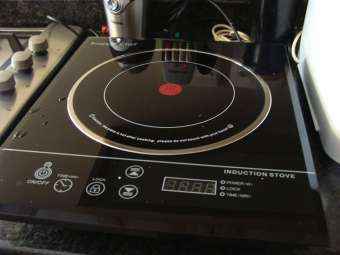
This page was last updated by Bernard Preston on 29th April, 2023.
You almost certainly played with bar-magnets and iron filings during your high school days, so this is hopefully not entirely unknown territory.
I'm working up to something very important, so bear with me; and useful in your kitchen, especially if you are a busy person and need instant-heat. If you are also committed to reducing your electrical bill, then tomorrow you will rush out and buy one of these.
An induction stove uses less than half of the power of its conventional cousin; more important, it heats extremely fast. You can literally boil an egg in just a few-minutes; now that has got you interested, I hope even if these maps of magnetic fields hasn't.
Induction Cooktop Stoves
Induction cooktop stoves use half the energy of a conventional electric-hob.
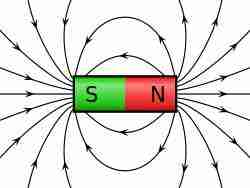
Much more interesting and useful is the magnetic field generated around wires carrying an electrical-current; and even in a solenoid displayed below. Now we have the potential to turn this magnetism into something useful in your home; heat.
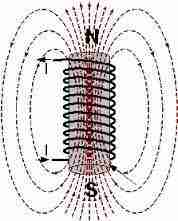
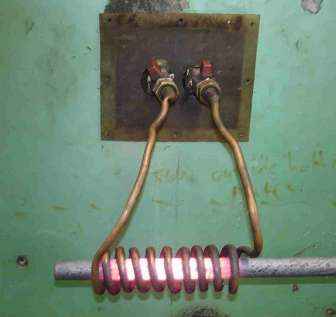
Electricity produces magnetic fields that we can use; in a moment
we will see that an alternating current, like that you have in your home is even more beneficial; it has a heat application. If you are interested you can read more about it at this magnetic induction[1] page.
Can you see how this rod glowed in the centre of the solenoid when early researchers passed an alternating current through a wire wrapped around the iron? Notice the cable is not actually touching the core metal. The electricity is not passing through that steel; it is the magnetic-induction that is producing the heat.
Only in your home, it will not be a rod that is being heated; it is the base and sides of your cooking pots that receive the energy directly from the magnetic-field produced by that alternating current.
Eddy currents in your steel-pot, set up by the AC, generate heat immediately you switch on; you don't have to wait for the element to get hot and then slowly transfer that energy to the base of the pan.
The base and sides, in effect are used as the heating element. That energy is then transferred to the contents of the pot in the normal way.
Without wanting to become neurotic, much of the gadgetry in home and industry may in time turn out to be toxic to human beings; it took many decades for researchers to realise the affect of x-rays and radiation. Will we one day have to add microwave and even induction stove cooking to that list?
With magnetic induction-stoves the heat is generated in the metal of the pot itself; which then warms your soup.
Well you may well be thinking, as I am, what does magnetic-induction do to us? Could it too be toxic to humans. Maybe, but we are already exposed to the fields produced by those conventional coils in your stove; and from all those other gadgets in your home.
Even the Earth has a magnetic field, and to our knowledge that hasn't affected humans adversely. And now there are many questions being asked about the radiation from 5G transmitters.
You could wear a lead-apron in the kitchen if it bothers you, as radiographers do.
So let us get directly to one of these induction cooktop stoves; there are full hobs using these principles but they are expensive. Actually I have just seen a Bosch for under $300 with four of these plates.
Best of all would a mixed fuel hob which has both induction plates and gas all in one; for example that by AEG for about 700 pounds sterling; shop around. That would definitely be my choice if I was putting in a new kitchen today.
If a saving of more than half the electricity and 64 percent of the time to get your dinner cooking does not impress you, I'll be surprised.
Newsletter
Our newsletter is entitled "create a cyan zone" at your home, preserving both yourself and Mother Earth for future generations; and the family too, of course. We promise not to spam you with daily emails promoting various products. You may get an occasional nudge to buy one of my books.
Here are the back issues.
- Lifestyle and ideal body weight
- What are ultra-processed foods?
- Investing in long-term health
- Diseases from plastic exposure
- Intensive lifestyle management for obesity has limited value
- A world largely devoid of Parkinson's Disease
- The impact of friendly bacteria in the tum on the prevention of cancer
- There's a hole in the bucket
- Everyone is talking about weight loss drugs
- Pull the sweet tooth
- If you suffer from heartburn plant a susu
- Refined maize meal and stunting
- Should agriculture and industry get priority for water and electricity?
- Nature is calling
- Mill your own flour
- Bake your own sourdough bread
- Microplastics from our water
- Alternative types of water storage
- Wear your clothes out
- Comfort foods
- Create a bee-friendly environment
- Go to bed slightly hungry
- Keep bees
- Blue zone folk are religious
- Reduce plastic waste
- Family is important
- What can go in compost?
- Grow broad beans for longevity
- Harvest and store sunshine
- Blue zone exercise
- Harvest and store your rainwater
- Create a cyan zone at your home
Whether you are cooking green beans, boiling brown rice or frying an egg, it is all about a very nifty induction stove.
One thing that impresses me is that there are eight magnetic induction settings, from 200 watts up to 2kW.
Actually I would like to have a 100W setting; even the existing lowest value is a little fast for cooking your oats porridge for breakfast, for example.
On gas you have to carefully turn the dial right down in the wrong, less safe direction; half the time it goes out. These portable induction stoves are so hassle free and priced under one hundred dollars, should be on every shopping list. Get a 2000W unit if you can find one. Your pole beans will be boiling is seconds.
It also has a useful timer.
Steel-based and caste iron pots only
You shouldn't be using aluminium pots anyway; they have been implicated in Alzheimer's disease. But copper-based pots won't work either with magnetic induction.
Make sure you clean the filter beneath your induction cooktop stoves regularly; a fan is used to cool the coil.
Solar junkie
If you're a greenie and have built a solar powered generator, then of course these energy efficient induction cooktop stoves mean that you can cook during the day for free.
But even if you're using mains, you can probably bank on saving at least a dollar or two per day by using a portable induction stove like this.
- heating water for tea or coffee.
- boiling or frying an egg for breakfast.
- heating your Boston baked beans for lunch.
- cooking your dinner.
The perfect option is a mixed gas and induction cooktop stove, but for that you'll have to wait. So will I; initially they will be expensive as manufacturing companies cash in on a new fashion. This isn't one that we'll change next year, though. Induction cooking is here to stay.
Solar power energy
Solar power energy can drive any electrical device, especially those that draw little current like your induction cooktop stoves.
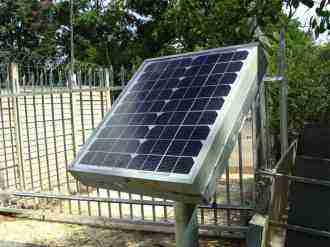
The time has really arrived when every one of us should be thinking of ways to use the energy from the sun.
It might be to charge your cellphone, or this small ten watt photovoltaic panel which I use to charge the small battery that powers our front gate. This has the advantage of not requiring a solar generator; so it's easy and safe to set up. Because it is only 12 volts we saved a huge amount by not needing an electrician to set up a 220V line.
You really could do this yourself; read more at residential solar panels. Incidentally, depending on how often that gate opens and closes, and how much inclement weather you have, 10W is too small; choose rather a unit double that size.
But to power your induction cooktop stoves you'll need 110 or 220 volts, alternating current; and a much bigger panel than this baby.
To go green is a step by step process; quite expensive upfront costs but knowing that you'll get it all back. Your portable induction stove will pay for itself in a few months; the speed and convenience of cooking is the real feature.
But for a solar generator you are looking at a payback time of seven or more years.
Solar power energy is free but collecting and storing it doesn't come cheap.
Start changing your fluorescent and incandescent lamps for extremely low energy Light Emitting Diodes. If you buy LED light bulbs you will literally reduce your lighting bill by 95%. I'm not exaggerating, but do your homework first; there are a few decisions to be made first.
The biggest user of energy in the home is the hot water geyser; it uses half of your electricity bill. To my mind, it's the very first step, but it is complex in very cold climates if you want to go solar; you will need specialised help if you live in Chicago.
However, an induction geyser is a good option; half the power too, I would presume.
In a few months I'll do a page on an induction hot water geyser.
Useful links
- Electromagnetic induction
- Solar PV systems - must you be grid tied?
When browsing use right click and Open Link in New Tab, or you may get a bad gateway signal.
Bernard Preston
Bernard Preston is a greenie, turned solar junkie. Whilst not choosing to go off the grid, because of the heavy cost of a large battery bank, or off the water mains, because of regular droughts in Southern Africa, he has successfully made every attempt to become large independent of the utilities; modern devices such as induction cooktop stoves simply make it easier.
Did you find this page interesting? How about forwarding it to a friendly book or food junkie? Better still, a social media tick would help.
- Bernard Preston homepage
- Solar geek
- Induction Cooktop Stoves
Address:
56 Groenekloof Rd,
Hilton, KZN
South Africa
Website:
https://www.bernard-preston.com